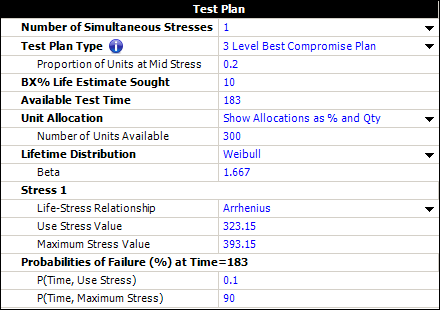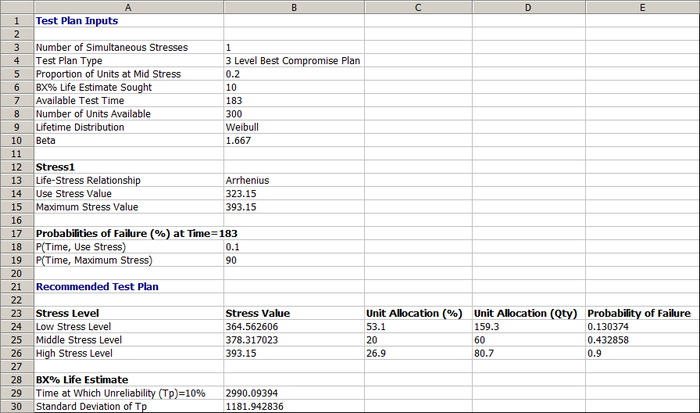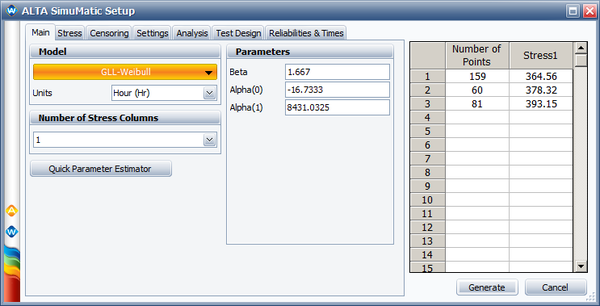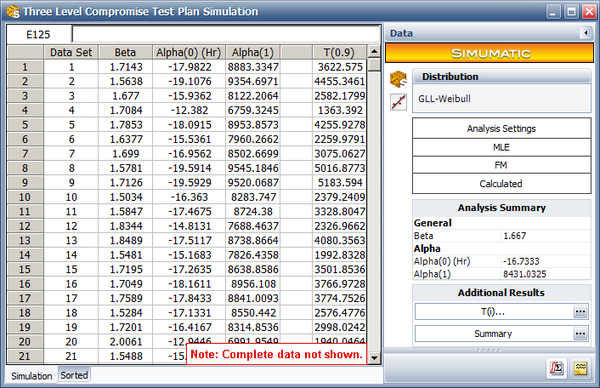Three Level Compromise Test Plan for One Stress: Difference between revisions
Jump to navigation
Jump to search
Kate Racaza (talk | contribs) No edit summary |
Kate Racaza (talk | contribs) No edit summary |
||
| (3 intermediate revisions by the same user not shown) | |||
| Line 1: | Line 1: | ||
{{Reference Example| | {{Reference Example|{{Banner ALTA Reference Examples}}}} | ||
This example | This example validates the results for the 3 level best compromise test plan with one stress in ALTA. | ||
| Line 11: | Line 11: | ||
{{Reference_Example_Heading2}} | {{Reference_Example_Heading2}} | ||
A Weibull distribution with an Arrhenius life stress relationship is used. The Arrhenius relationship uses the following formula: | A Weibull distribution with an Arrhenius life-stress relationship is used. The Arrhenius relationship uses the following formula: | ||
::<math>ln(\eta) = \beta_{0} + \beta_{1} \times \frac{11605}{T}\,\!</math> | ::<math>ln(\eta) = \beta_{0} + \beta_{1} \times \frac{11605}{T}\,\!</math> | ||
| Line 30: | Line 30: | ||
{{Reference_Example_Heading3}} | {{Reference_Example_Heading3}} | ||
The | The 3 level compromise test plan is: | ||
* 156 units should be tested at 78°C (351.15°K) | * 156 units should be tested at 78°C (351.15°K) | ||
| Line 46: | Line 46: | ||
The resulting | The resulting test plan is shown below. | ||
| Line 52: | Line 52: | ||
The test plan shows that: | The test plan shows that (starting at row 24 in the picture above): | ||
* The low stress level | * The low stress level should be 364.56°K (91.41°C) and about 159 units should be tested at this temperature. | ||
* The middle stress level | * The middle stress level should be 378.32 °K (105.17°C) and about 60 units should be tested at this temperature. | ||
* The high stress level | * The high stress level should be 393.15 °K (120°C) and about 81 units should be tested at this temperature. | ||
The estimated standard deviation of the log B10 life at 50°C can be obtained by: | The estimated standard deviation of the log B10 life at 50°C can be obtained by: | ||
::<math>Ase\left[log \left(\hat{t}_{0.1}(50) \right) \right] = \frac{Ase\hat{t}_{0.1}(50)}{\hat{t}_{0.1}(50)} = \frac{1181.94}{2990.09} = 0.3953\,\!</math> | ::<math>Ase\left[log \left(\hat{t}_{0.1}(50) \right) \right] = \frac{Ase\left(\hat{t}_{0.1}(50)\right)}{\hat{t}_{0.1}(50)} = \frac{1181.94}{2990.09} = 0.3953\,\!</math> | ||
| Line 67: | Line 67: | ||
'''Using | '''Using SimuMatic to Evaluate the Test Plan''' | ||
We will use the SimuMatic utility to evaluate the test plan. The following picture shows the settings used in the Main tab of SimuMatic (with <math>\alpha_{1} = \beta_{1} \times 11605\,\!</math>): | We will use the ALTA SimuMatic utility to evaluate the test plan. The following picture shows the settings used in the Main tab of SimuMatic (with <math>\alpha_{1} = \beta_{1} \times 11605\,\!</math>): | ||
[[Image: Compromise plan simumatic.png|center|600px]] | [[Image: Compromise plan simumatic.png|center|600px]] | ||
The rest of the SimuMatic | The rest of the settings in SimuMatic are as follows: | ||
* Stress tab: | * Stress tab: | ||
| Line 82: | Line 82: | ||
* Settings tab | * Settings tab | ||
::Seed = '''10''', Precision = '''4''', Number of data sets = '''1000''' | ::Seed = '''10''', Precision = '''4''', Number of data sets = '''1000''' | ||
* Reliabilities and Times | * Reliabilities and Times tab | ||
::Reliability value = '''0.9''' | ::Reliability value = '''0.9''' | ||
| Line 91: | Line 91: | ||
We take the | We take the natural log of the B10 life (the last column) and calculate its standard deviation. The calculated standard deviation is 0.4062. This is very close to the analytical solution from the ALTA test plan tool, where the standard deviation is 0.3953. | ||
This standard deviation is smaller than the standard deviation given by the test plan in the book. Therefore, the test plan generated in ALTA is better than the test plan given in the book in terms of minimizing the estimation variance of the B10 life. | This standard deviation is smaller than the standard deviation given by the test plan in the book. Therefore, the test plan generated in ALTA is better than the test plan given in the book in terms of minimizing the estimation variance of the B10 life. | ||
Latest revision as of 18:24, 28 September 2015
New format available! This reference is now available in a new format that offers faster page load, improved display for calculations and images and more targeted search.
As of January 2024, this Reliawiki page will not continue to be updated. Please update all links and bookmarks to the latest references at ALTA examples and ALTA reference examples.




